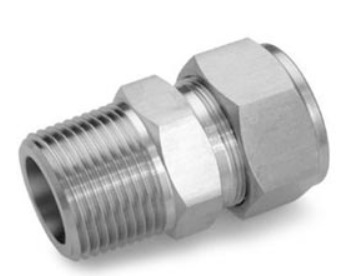Ferrule tube fittings are mechanical components used to connect tubes and pipes in fluid systems. They consist of a nut, a back ferrule, a front ferrule, and a body. When assembled correctly, these fittings provide a tight seal, ensuring smooth fluid flow without leaks.
In this article, we will explore ferrule tube fittings. We will cover their basic definition, applications, and advantages.
What is a Ferrule Tube Fitting?
Single Ferrule Tube Fitting
A ferrule tube fitting is a type of compression fitting. It is used to join tubes and provide a secure connection. It comprises a front ferrule, which bites into the tube. A back ferrule helps create a strong grip when the nut is tightened. This design guarantees a trustworthy and leak-proof connection.
Types of Ferrule Tube Fittings
Compression Ferrule Tube Fittings
Compression ferrule tube fittings are the most common type. They consist of a nut, a front ferrule, and a back ferrule. The front ferrule forms a seal between the fitting body and the tube, while the back ferrule provides support and grip.
Bite-Type Ferrule Tube Fittings
Bite-type ferrule tube fittings feature a sharp ferrule. It bites into the tube when the nut is tightened, creating a secure connection. These fittings are ideal for high-pressure applications. They offer excellent resistance against vibration and thermal cycling.
Flare Fittings
Flare fittings are used in applications where frequent disassembly is necessary. They consist of a body with a coned or flared end that matches the flare on the tube. When assembled, the flare provides a tight seal.
Push-to-Connect Fittings
Push-to-connect ferrule tube fittings are designed for quick and easy installation. They feature a collet mechanism that grips the tube when inserted. This creates an instant and secure connection without the need for special tools.
Advantages of Ferrule Tube Fittings
Ferrule tube fittings offer several advantages, making them popular choices in various industries:
➡️ Reliable Sealing: Ferrule tube fittings create a reliable seal, preventing leaks and ensuring the integrity of fluid systems.
➡️ Easy Installation: These fittings are relatively easy to install, saving time and labor costs during assembly.
➡️ Wide Application Range: Ferrule tube fittings can be used with various tube materials and fluids, making them versatile for different applications.
Common Materials Used in Ferrule Tube Fittings
Ferrule tube fittings are made from different materials to suit specific applications. Common materials include stainless steel, brass, aluminum, and plastic. The choice of material depends on factors such as the type of fluid, temperature, and pressure requirements.
How to Choose the Right Ferrule Tube Fitting
When selecting a ferrule tube fitting, consider factors such as tube material, fluid compatibility, temperature, pressure, and environmental conditions. Proper selection ensures a secure and long-lasting connection.
Installation Process of Ferrule Tube Fittings
➡️ Prepare the Tube: Ensure the tube end is cut squarely and deburred to prevent damage to the ferrule and ensure a proper seal.
➡️ Insert the Ferrules: Slide the back ferrule onto the tube first, followed by the front ferrule.
➡️ Insert the Tube: Insert the prepared tube into the fitting body until it bottoms out.
➡️ Tighten the Nut: Hand-tighten the nut until snug, then use a wrench to tighten it further. Avoid over-tightening, as it may damage the ferrules.
Applications of Ferrule Tube Fittings
Ferrule tube fittings find applications in various industries, including:
➡️ Oil and Gas: Used in hydraulic systems for controlling fluid flow in drilling operations.
➡️ Pharmaceuticals: Ensure sterile connections in the production of pharmaceuticals and medical devices.
➡️ Chemical Processing: Ideal for handling corrosive chemicals, providing leak-free connections.
➡️ Automotive: Used in fuel lines and brake systems, ensuring reliable fluid connections in vehicles.
Maintenance and Troubleshooting Tips
➡️ Regular Inspection: Periodically inspect fittings for signs of wear, corrosion, or damage.
➡️ Proper Lubrication: Apply lubricant to the threads and ferrules to ensure smooth assembly and prevent galling.
➡️ Address Leaks Promptly: If a leak is detected, disassemble the fitting, inspect the ferrules, and reassemble following proper procedures.
Comparing Ferrule Tube Fittings with Other Connection Methods
Ferrule tube fittings offer advantages. These include ease of installation, flexibility, and reusability. Compared to other connection methods like threaded and welded joints. They do not require special tools or extensive training. This makes them a cost-effective choice for many applications.
Industry Standards and Certifications
Ferrule tube fittings are manufactured to meet industry standards and certifications. This ensures their quality and performance. Common standards include ASTM, ASME, and ISO certifications. They guarantee the fittings’ compliance with specific requirements.
FAQs about Ferrule Tube Fittings
Q1: Are ferrule tube fittings reusable?
Yes, ferrule tube fittings are generally reusable if they are not damaged during disassembly. Proper care during installation and removal ensures their reusability.
Q2: Can ferrule tube fittings be used in high-temperature applications?
Yes, ferrule tube fittings made from materials like stainless steel can withstand high temperatures. Therefore, they are suitable for applications involving elevated heat.
Q3: What is the difference between compression and bite-type ferrule tube fittings?
Compression fittings use both a front and a back ferrule, while bite-type fittings have a sharp ferrule that bites into the tube. Bite-type fittings are ideal for high-pressure applications and offer excellent vibration resistance.
Q4: Can ferrule tube fittings handle corrosive chemicals?
Yes, ferrule tube fittings are made from corrosion-resistant materials, such as stainless steel or specific alloys. They can effectively handle corrosive chemicals, ensuring safety and integrity.
Q5: How can I prevent over-tightening ferrule tube fittings?
To prevent over-tightening, hand-tighten the nut until snug, and then use a wrench to provide a slight turn. Avoid excessive force, as it may damage the ferrules and lead to leaks.
Conclusion
Ferrule tube fittings play a vital role in fluid systems. They provide secure, leak-free connections in various industries. They are essential parts because of their adaptability, dependability, and simplicity of installation. By understanding the types, advantages, and applications of ferrule tube fittings, industries can optimize their fluid systems. They can also ensure efficient operations.
Post time: Dec-14-2023


